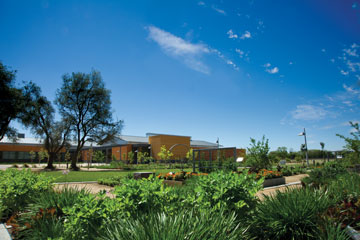Volume 28 · Number 4 · Summer 2011
Campus Views

The Good Life Garden at UC Davis' Robert Mondavi Institute for Wine and Food Science. (Karin Higgins/UC Davis)
The Good Life Garden
Before the first greenery came into view, I could smell the earthy sweetness of basil and onions. Goldy honey bear sunflowers with radiant orange petals towered over the Good Life Garden as I approached.
Amid the plants, people crouched and snipped herbs, tucking them into plastic bags. I headed toward clumps of basil.
Butterflies and bees swarmed the fragrant plants. As I snipped, a tiny green bug landed on my arm. I moved to the lavender, its thigh-high deep purple buds clustered on silvery stalks. I cut a few stems to put in a vase.
About a half-dozen times a year, the campus community and public are invited to harvest the herbs. But the nearly 3-year-old garden, located in the courtyard of the Robert Mondavi Institute for Wine and Food Science, is more than a source of free seasoning. Unlike other landscaping that functions to prevent erosion and requires minimal redesign work, this garden — like so many other aspects of UC Davis — aims to educate.
The Good Life Garden is a mostly edible, organic and ever-changing landscape, overflowing with vegetables, fruits, herbs and flowers meant to show that "good food equals good health."
The nearly one-acre garden grows 40 to 50 varieties of herbs and ornamental plants, such as oregano and society garlic; about 22 kinds of fruit trees, including Meyer lemon and pomegranate; more than two dozen varieties of mostly seasonal vegetables, and flowers. There are small groves of olive and dwarf citrus trees, a section of plants that have been used since medieval times to make beer and a bed of plants that reflect the complex flavor profiles of wine. Paths crisscross the beds, allowing visitors to smell and touch what is growing.
"Usually these kinds of things would end up in a field someplace, surrounded by a fence to keep people out," said Sal Genito, director of buildings and grounds. "We're trying to bring people in … and discover something new."
The hope, Genito said, is to inspire visitors to plant their own edible gardens at home. The "shovel to fork" demonstration garden is meant to educate the campus and the public about gardening and nutrition, helping home gardeners cultivate their own bumper crops and home cooks choose produce at its flavor and nutritional peak. Plaques reflecting what's growing offer historical tidbits, health facts and gardening tips. To raise money for maintenance, the garden is rented out for weddings and corporate events and plays host to fundraisers.
Development Analyst Jennifer Wade '03, an herb harvest regular, was picking purple and green basil for pesto. "The dinner plans have changed," she said.
Wade appreciates the gardening tips issued through Facebook and a blog. "I like coming every season to see … how it changes and also to get some inspiration for my own yard," she said. "I think mixing both the education and the ability to come use the garden is pretty special."
An atypical project for a landscape architect, the garden initially drew Christina DeMartini Reyes out of her comfort zone. Seasonal planting is complex. Reyes considers, in part, previous plantings and plants that will attract beneficial insects. She also uses companion planting. Leeks, lettuce and carrots are good to plant together, for example. A leek's aromatic properties repel pests that might feast on carrots and lettuce. Fast-growing lettuce shades the root vegetable's seeds, letting them germinate. And harvesting the lettuce leaves more room for carrots just starting to grow.
Reyes consults with Seeds of Change, an organic seed company that donates most of the garden's seeds, and gets feedback from gardener Pat Stoffel.
She sometimes chooses plants that may not be the most productive or the tastiest but look stunning, like the combination of purple basil, white alyssum and strappy gray-green-leafed leeks.
Visitors, she hopes, will be "blown away by how beautiful (an edible garden) can be when it's at its best."
The herb harvest drew Henry Hao, a doctoral student in economics, who was cutting basil for two Chinese dishes he planned to fry that night with eggs and chicken.
"It's really interesting," he said of the garden. "A lot of spices and many ingredients for us to look at. It's beautiful here. It smells so great."
